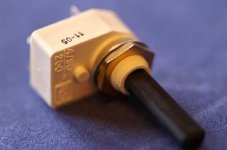Yes. The center is the signal, the shield is ground. (Return)
The VGA cables are probably perfect!
I have been using cable scraps for hook-up wire for so long I can't remember the last time I actually purchased wire.
Sure, but where do you purchase your color matched cable ties?
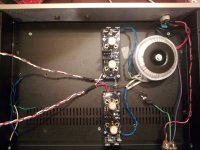
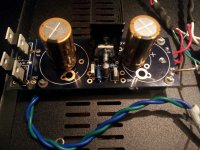
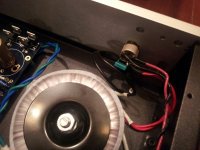
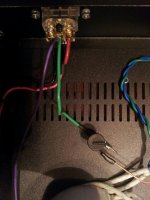 Well, I started up the BA-3...actually just the power supply.
Well, I started up the BA-3...actually just the power supply. Immediately popped a 2A fast blow fuse. Damn it.
while I am assembling a bulb tester you guys have any ideas?
Here's whats going on:
- From the power inlet Red is Live, black is N.
- Antek transformer, Primary has two leads for power. Red and Red/ black and black tied to each other (i.e. red + red = live, black + black = N) after the power switch.
- Purple wire is transformer "static shield" that should be grounded.
- Secondaries to the PSU boards. Each set of secondaries (green and blue) measure infinate resistance between them.
- Cap on the output of the power switch (Y rated)
- Doesn't matter which secondaries go to the diode bridge right? It's AC so I think it doesn't matter. It's not like the A/C connections on the diode board are specific, right?
- Leads from the PSU (red/White/Green) are not connected to anything yet.
- I briefly measured about 5V on the PSU before I realized the fuse was blown.
Could this just be the the startup load that blew the fuse? I have 1A slow-blow fuses I will use but I thought I'd start it with a fast blow to be safe.
Last edited:
Purple wire is transformer "static shield" that should be grounded.
Attach that wire to screw where the thermistor is attached, not AC earth. It's a subtle change, but still worth doing. (That's not causing the fuses to blow, however)
Yes and no, make sure the blue/green are attached to the same places on each bridgeDoesn't matter which secondaries go to the diode bridge right? It's AC so I think it doesn't matter. It's not like the A/C connections on the diode board are specific, right?
Take all that off, including the tied grounds and see if each individual PCB is working properly.- Leads from the PSU (red/White/Green) are not connected to anything yet.
Try the slow, but I doubt that those PSU caps should pop a 2A fast...Could this just be the the startup load that blew the fuse? I have 1A slow-blow fuses I will use but I thought I'd start it with a fast blow to be safe.
vdi_nenna said:Is a thermistor necessary is this application?
Can't hurt, and will probably help the overall noise floor.
Last edited:
I'll look at the A/C connection from the transformer to the diode board. I am not sure if each board is hooked up the same way. I thought it didn't matter.
6L6, good idea to test each board independently…I'll try that.
Vienna, the thermistor is just a ground loop breaker/isolator. Maybe I should leave it out when testing. Maybe it's safer that way.
Also I should not that when switched on there was quite a spark/arc inside the power switch. It has a transparent window on the back of the switch and there was some arcing when switched on. Is this normal?
6L6, good idea to test each board independently…I'll try that.
Vienna, the thermistor is just a ground loop breaker/isolator. Maybe I should leave it out when testing. Maybe it's safer that way.
Also I should not that when switched on there was quite a spark/arc inside the power switch. It has a transparent window on the back of the switch and there was some arcing when switched on. Is this normal?
DPST. Here's the specs:
----------------------------------------
RS-4A
A DPST switch with a glass-loaded flame retardant body and spindle, and silver contacts.
Capable of withstanding inrush current of 64A for 10ms.
Contact rating 250VAC 4A
Angle of rotation 45°
Made in UK
Weight :12 (gram/each)
----------------------------------------
RS-4A
A DPST switch with a glass-loaded flame retardant body and spindle, and silver contacts.
Capable of withstanding inrush current of 64A for 10ms.
Contact rating 250VAC 4A
Angle of rotation 45°
Made in UK
Weight :12 (gram/each)
Attachments
The 317/337 can do +/- 25V -- the regulator I am using is exactily that.
You need to change a resistor value or two in order to get that voltage. Easy enough to figure out, or just ask for a hand.
The most important thing, however, is the voltage rating of your capacitors - look at your reg and see what they are. If they are 25V or better, you are good to go, if not you probably need to swap a few new ones in.
You need to change a resistor value or two in order to get that voltage. Easy enough to figure out, or just ask for a hand.
The most important thing, however, is the voltage rating of your capacitors - look at your reg and see what they are. If they are 25V or better, you are good to go, if not you probably need to swap a few new ones in.

My QC guy testing Front-end

Passed!

PSU wiring. Sometimes I think the only trick to making this stuff look fairly good is the copious use of zipties...


Vince - this photo is for you - it shows the PCB connections, I will get a shot of the attenuator as well. You can do it with no changes to the PCB.
I realise this is a bit of a teaser, but more photos later. The short story is that it works, biases properly, is very quiet, and sounds as good as I've been imagining!
I will also measure and illustrate the effects of changes to P3.
Until then,
Happy Thanksgiving everybody!
- Home
- Amplifiers
- Pass Labs
- BA-3 As Preamp
